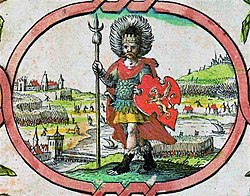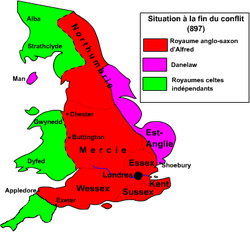Wessex
Wessex was an old Anglo-Saxon kingdom before England became one country. It was one of seven kingdoms in England. It was named after the West Saxons. It was in the south and southwest of England. Wessex was a kingdom from the 6th century until the English state was made in the 9th century. It was an earldom between 1016 and 1066. Then "Wessex" was not an official place name. The 19th century novelist Thomas Hardy wrote about Wessex in his books which tell stories set in that area.
Kingdom of the West Saxons Westseaxna rīce (Old English) | |||||||||
|---|---|---|---|---|---|---|---|---|---|
| 519–927 | |||||||||
 The Kingdom of Wessex in 900 AD | |||||||||
| Capital and largest city | Winchester | ||||||||
| Official languages | Old English | ||||||||
| Common languages | Old English (official), Latin | ||||||||
| Religion |
| ||||||||
| Government | Absolute Monarchy | ||||||||
| King | |||||||||
• 519–534 (first) | Cerdic | ||||||||
• 924–927 (last) | Athelstan | ||||||||
| Legislature | Witenagemot | ||||||||
| Historical era | Heptarchy | ||||||||
• | 519 | ||||||||
• | 927 | ||||||||
| Currency | Penny | ||||||||
| |||||||||
His Royal Highness The Prince Edward was given the title "Earl of Wessex" when he married Sophie who became the Countess of Wessex. The title Earl of Wessex had not been used since the last earl, King Harold Godwinson, was killed at the Battle of Hastings in 1066.
Wessex Media
Imaginary depiction of Cerdic from John Speed's 1611 "Saxon Heptarchy"
Anglo-Saxon–Viking coin weight, used for trading bullion and hacksilver. The material is lead and it weighs 36 g (1.3 oz). Embedded with an Anglo-Saxon sceat (Series K type 32a) dating to 720–750 and minted in Kent. It is edged in a dotted triangle pattern. Its origin is the Danelaw region and dates to 870–930
The Bayeux Tapestry, depicting the death of Harold II, 14 October 1066. His "Wyvern Standard" can be clearly seen at the left side.











